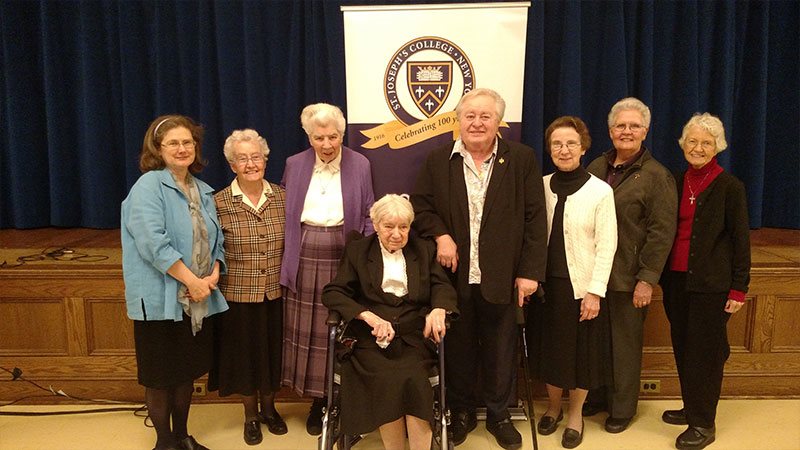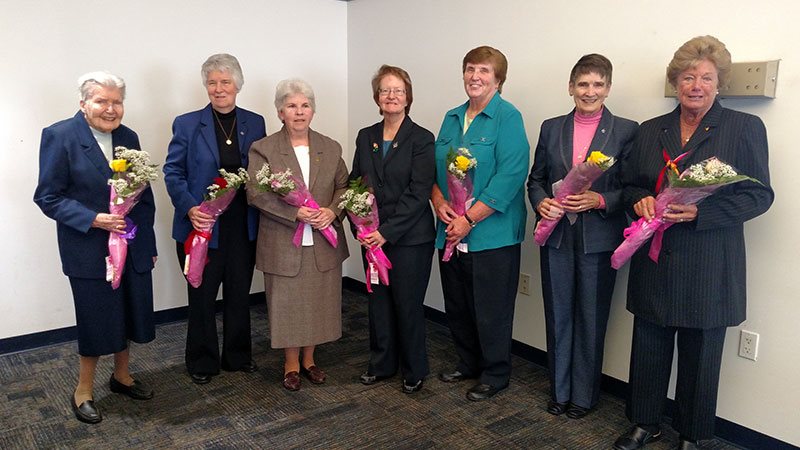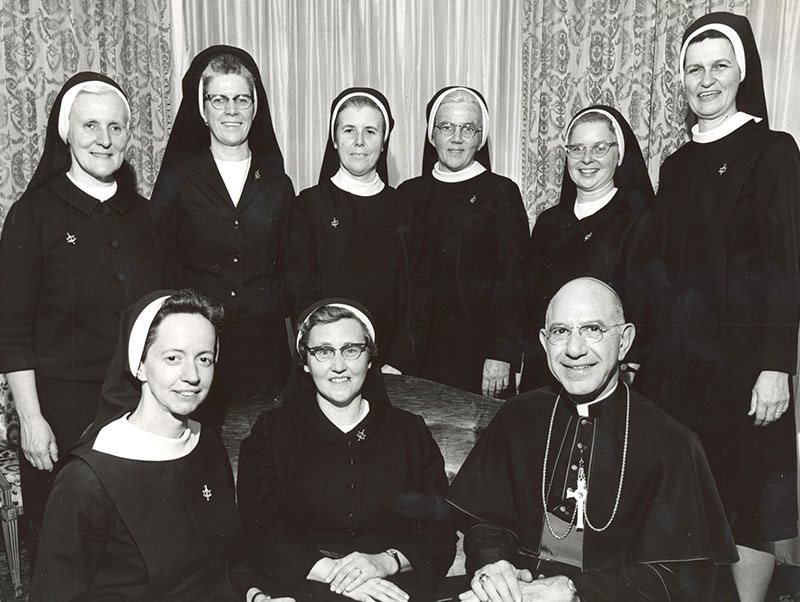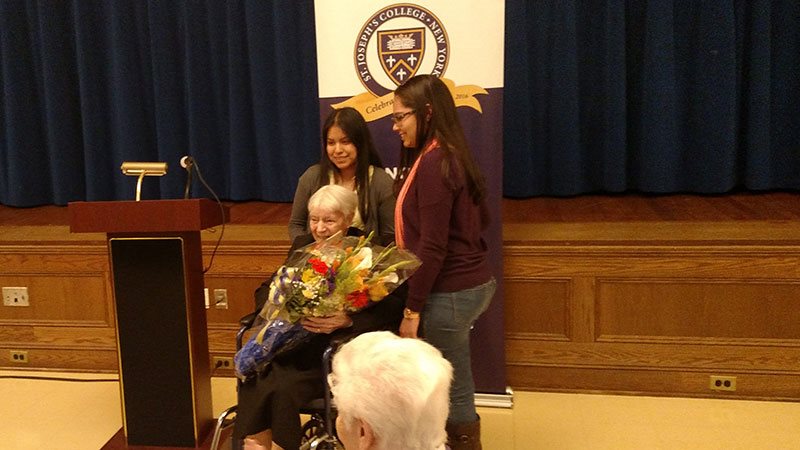BROOKLYN
245 Clinton Ave., Brooklyn, NY 11205
Main: 718.940.5300
Admissions: 718.940.5800
Fax: 718.940.5680
LONG ISLAND
155 W. Roe Blvd., Patchogue, NY 11772
Main: 631.687.5100
Admissions: 631.687.4500
Fax: 631.687.4539
March 17, 2016
 Honoring the Sisters of St. Joseph at SJC Brooklyn and Long Island
Honoring the Sisters of St. Joseph at SJC Brooklyn and Long Island
Every year, Saint Joseph, the patron saint of workers and the protector of families, is honored on March 19. Legend has it that a famine in Sicily was resolved when villagers prayed to Saint Joseph, and as a result, he has been honored with ample feasts of pasta, soups, bread and pastries ever since.
At St. Joseph’s College, the tradition continued on Tuesday, March 15, at SJC Brooklyn and on Wednesday, March 16, at SJC Long Island.
On the Brooklyn Campus, attendees were treated to a reflection by S. Mary Florence Burns (reproduced below). S. Mary Florence gave a brief history of St. Joseph's College, its first graduates and the origins of our campus. Before the Brooklyn-based Sisters renewed their vows, S. Alice Francis Young — 100 years old — was presented with a bouqet of flowers and received a standing ovation from the audience. The reception ended with a buffet of pastas and salads, and a traditional Saint Joseph dessert.

L-R: S. Susan Wilcox, C.S.J.; S. Mary Sivillo, C.S.J.; S. Mary Florence Burns, C.S.J.; S. Alice Francis Young, C.S.J.; S. Carole Lessard, C.S.J.; S. Elizabeth A. Hill, C.S.J.; S. Pat Dittmer, C.S.J.; and S. Margaret Buckley, C.S.J.
At SJC Long Island, a Saint Joseph's Day Mass was celebrated by Father Francis Pizzarelli. The SJC Sharps provided choral accompiment during the gathering and recessional hymns, and a violin solo during the Preparation of the Gifts. Bryan Gill, director of student involvement and leadership, read a reflection of his experience with the Long Island-based Sisters of St. Joseph. From memories of working with S. Grace Edna Rowland in the Clare Rose Playhouse to speaking with S. Joan Ryan while he manned the front desk of the Danzi Center, Bryan lauded the Sisters for constant selflessness and generosity.

L-R: S. Miriam Honora Corr, C.S.J.; S. Eileen M. Kelly, C.S.J.; S. Jane Fritz, C.S.J.; S. Suzanne Franck, C.S.J.; S. Miriam Blake, C.S.J.; S. Mary Ann Cashin, C.S.J.; and S. Grace Edna Rowland, C.S.J.
Thanks to all those who attended our annual Saint Joseph's Day events on both campuses. And, once again, thank you to those Sisters of St. Joseph who've helped develop St. Joseph's College for Women into St. Joseph's College: a community of scholars, teachers, artists and providers.
Below, we've reproduced S. Mary Florence Burns' reflection on the Sisters of St. Joseph and the origins of the College.
St. Joseph’s College for Women, as it was then known, was founded by the Sisters of St. Joseph of Brentwood, in response to the need for a day college for young women. The College received its provisional charter from the Regents of the University of the State of New York on February 24, 1916. From its earliest days, the College articulated its mission in terms of academic quality, value orientation and career preparation.
As delivered by S. Mary Florence Burns, C.S.J. on Saint Joseph's Day
On this celebration of St. Joseph’s Day, almost one hundred years after the founding of St. Joseph’s College, we pause to consider how it all began. I’ve been asked to sketch in, very briefly, the origin and early development of the College, and the contribution of the Sisters of St. Joseph.
The First Announcement of St. Joseph’s College for Women proclaims that it had long been the desire of Bishop Charles McDonnell to establish a Catholic college for women in the Long Island Diocese and that the Bishop was happy to announce that it would be staffed by the Sisters of St. Joseph. And this was true. But the real beginning was a little bit different.
To put the beginnings in context, we need to recall that anti-Catholic prejudice was endemic in New York State, New York City, and Long Island in the nineteenth and early twentieth centuries. The impact of this prejudice was direct. One example: to reduce the hostile atmosphere, whenever the sisters left the convent, they wore straw hats to conceal their habits. That continued until the early 1920’s. In the educational sphere, graduates of the Academy of St. Joseph were accepted academically at Barnard College but were not welcomed socially.
To Reverend Mother Mary Louis, it therefore seemed clear that there was need for a Catholic college for graduates of the sisters’ academies, and so planning began for a college in Brentwood. Bishop McDonnell, however, noted that the Clinton Hill area was already an educational center including Adelphi, Cathedral, St. John’s, and St. Francis Colleges. And that settled the location.

Standing: Sister Francis Teresa, Sister Raymond, Sister John Raymond, Sister St. Angela (Regional Superior, and former Librarian at SJC,), Sister Joseph Damien (Professor of History) and Sister Virginia Thérèse (Congregational Councillor, former Professor of Chemistry; later, Vice President and Dean, SJC Long Island); seated: Sister George Aquin (president of SJC, 1969-1997), Sister Joan de Lourdes (General Superior of Sisters of St. Joseph; former Professor of History and Dean of Students) and Bishop Francis Mugavero (Bishop of Brooklyn).
S. Celestine Gill, who had opened St. Angela Hall Academy in 1906, became the point person in dealing with the New York State Education Department, and in relatively quick time the Regents confirmed that the Sisters were ready to undertake college-level work.
Reverend Mother Mary Louis asked Bishop McDonnell to chair the Board of Trustees, and as President of the Board, he became President of the College. S. Celestine Gill was named Dean. Sisters Lumena and Augustine Maria were the two Sister faculty. What is remarkable, truly remarkable for that period of history, is that these sisters already had Master’s degrees, at a time when most women did not finish high school and very few women had college degrees. The Congregation was way ahead of the American public in emphasizing the importance of education. By 1921, three sister faculty members had doctorates, and by 1925, five sister faculty had doctorates.
The curriculum was the traditional liberal arts curriculum: English; history; languages--Latin, Greek, Spanish, French; math; science, and of course, leading the list, religion. The program each semester called for approximately 25 hours of class. The number of credits is not spelled out until the second catalog in 1921. There was virtually no choice, although in second year, students could opt for Greek or analytical chemistry; and in third year, the option was for language or analytical geometry. Which would you have chosen? No fluff here.
An interesting side-note here. Oral tradition holds that the State Education Department would not approve the inclusion of the religion courses in the traditional 120 credits for the degree. The Sisters therefore added the religion credits to the total. There is no written evidence of this but it would explain why a St. Joseph’s College degree required 128 credits.
And where were the first classes held? From 1916 through June 1918, the College was located in one of the houses on the St. Angela Hall property, very different then from the present buildings.

Before the Brooklyn-based Sisters renewed their vows on Saint Joseph Day, S. Alice Francis Young — 100 years old — was presented with a bouqet of flowers. She received a standing ovation from the audience.
Who were the students? The first twelve pioneers came from three public and six Catholic high schools. They were, in fact, a remarkable group. Within the first semester they had formed a class organization, then outlined an Undergraduate Association that developed over the next three years. And during that first year they formed a literary society and arranged some social activities. They were strongly encouraged to participate in their local parish activities. Within their four years, the Twelve Apostles, as they were called, established a religion club, a French club, an orchestra and Glee Club, an athletic association and a varsity team, and a Dramatics Club. With the end of World War I , they were able to have a Junior Prom and a Senior Prom. And during Commencement week, the Dramatics Club staged Iphigenia in Taurus at the Brooklyn Academy of Music on June 14, 1920.
In the 1920 Yearbook, one of the students wrote of the “ triumphal progress from the dream to the reality – the evolution in four short years of St. Joseph’s College for Women.” And that triumphal statement reflects the confidence – and the achievements -- of the first twelve students, the Twelve Apostles.
There is no triumphal statement from the Sisters; there is no statement at all. But clearly the first twelve students needed a sense of what was expected at the college level and the support of experienced educators in creating this first Catholic college for women on Long Island. The first sister faculty established a very strong academic and student-centered environment that encouraged the students to grow intellectually and spiritually, and inculcated a strong sense of service.
One measure of the effectiveness of their education may be discerned in their post-graduate work. From the first class, one earned the Ph.D. and another the MD, and one graduate joined the Sisters of St. Joseph. From the second class came the second Ph.D. and the first JD. Clearly SJC students were well prepared. This is an extraordinary record for this period in American history -- and a tribute to the vision of the Sisters of St. Joseph very effectively communicated to the students. The rest is history.
Let me add that the contribution of the Sisters of St. Joseph extended far beyond the academic. In 1918, the Sisters bought the Pratt house at 243-251 Clinton Avenue – -and sold it to St. Josephs College for $1. Between 1923 and 1936, the Sisters paid for the extension on Waverly Avenue – now the student lounge and biology wing; bought the Metz house at 253 Clinton, had it razed and paid for the construction of the present main building, Touhy Hall; and finally, bought the Allison House at 265 Clinton Ave – now Lorenzo Hall. Each of these buildings was then given to St. Joseph’s College. The actual contribution from 1918 to 1936 was almost $800,000.
Then, of course, there was the ongoing education of the Sisters with Master’s and doctorates from Fordham, St. John’s, Minnesota, Catholic University, Yale, Pennsylvania, Columbia, and New York Universities. No one has tried to calculate that cost. And no one has tried to calculate the total of the contributed services of the Sisters. The Trustees reviewed the topic in 1972 and concluded that for the five year period, 1967-1971, the contribution equaled more than two million dollars. And that was just for five years.
As we approach the 100th anniversary of the founding, and look back over the number of women educated from 1916 to 1970, and since then, the number of men as well as women, we give thanks for the vision, courage, and determination of the founding sisters, and the generosity of the Congregation. May God continue to bless St. Joseph’s College and the Congregation of the Sisters of St. Joseph.
Get Social
Get Social